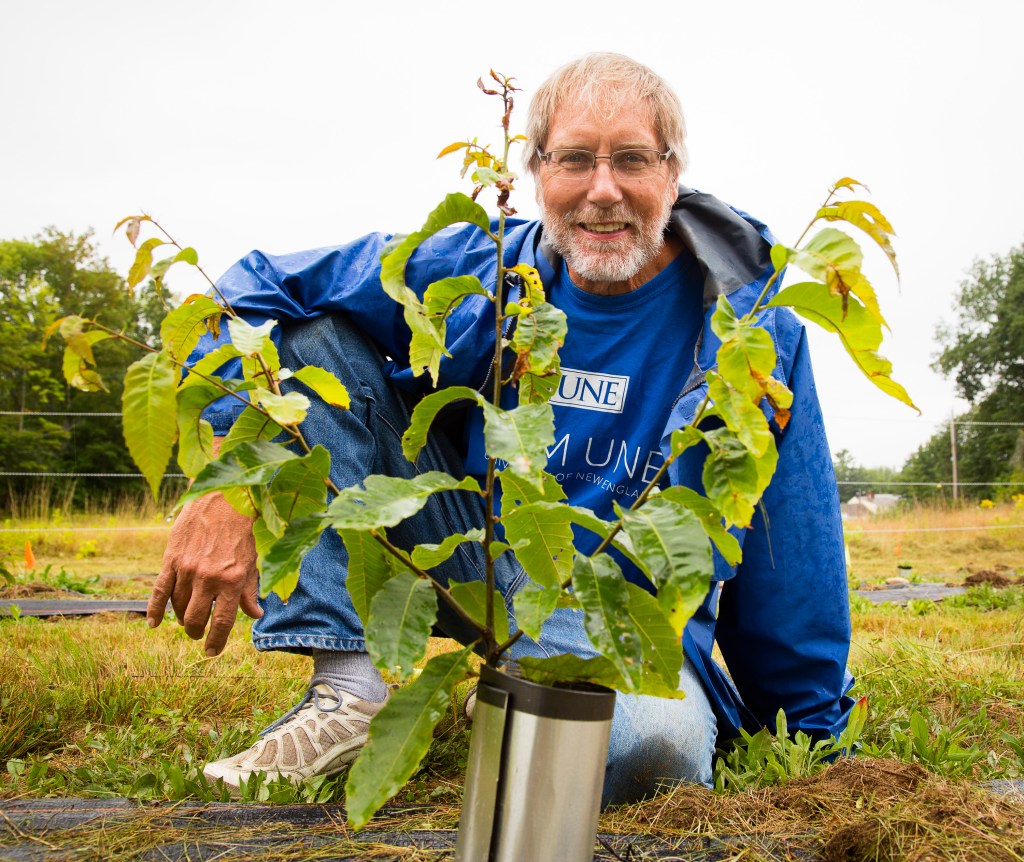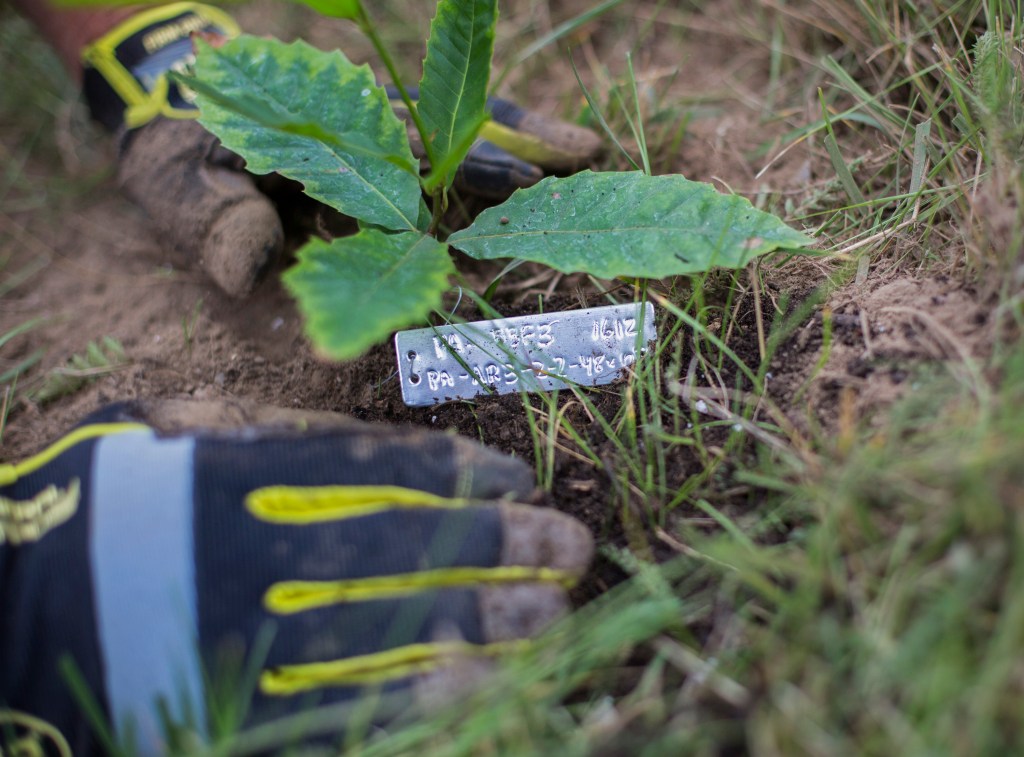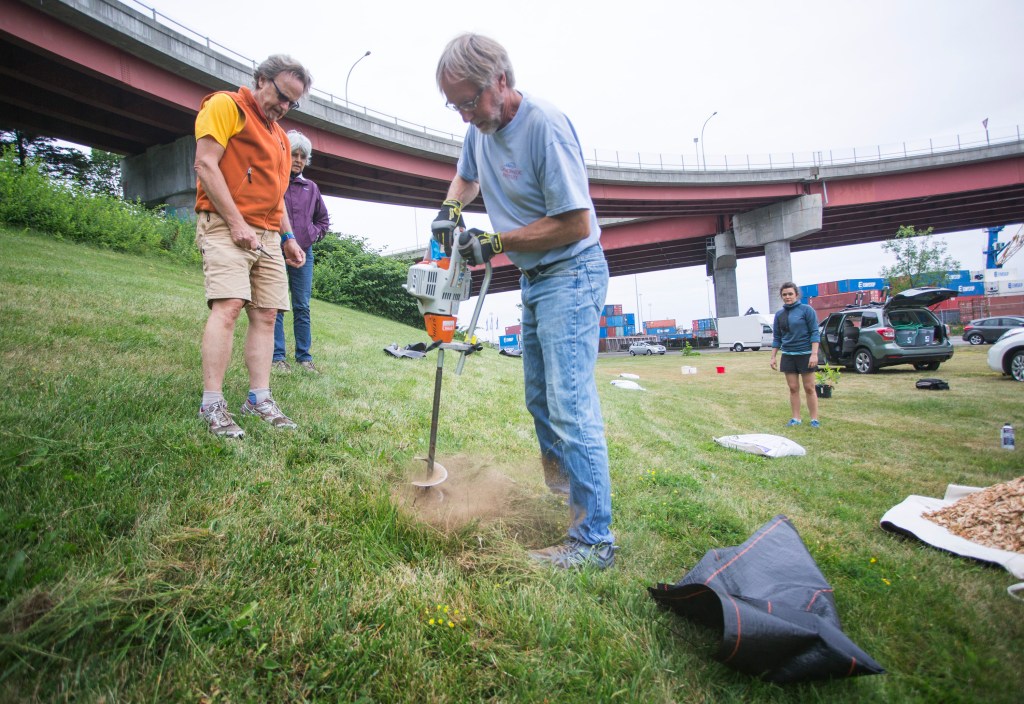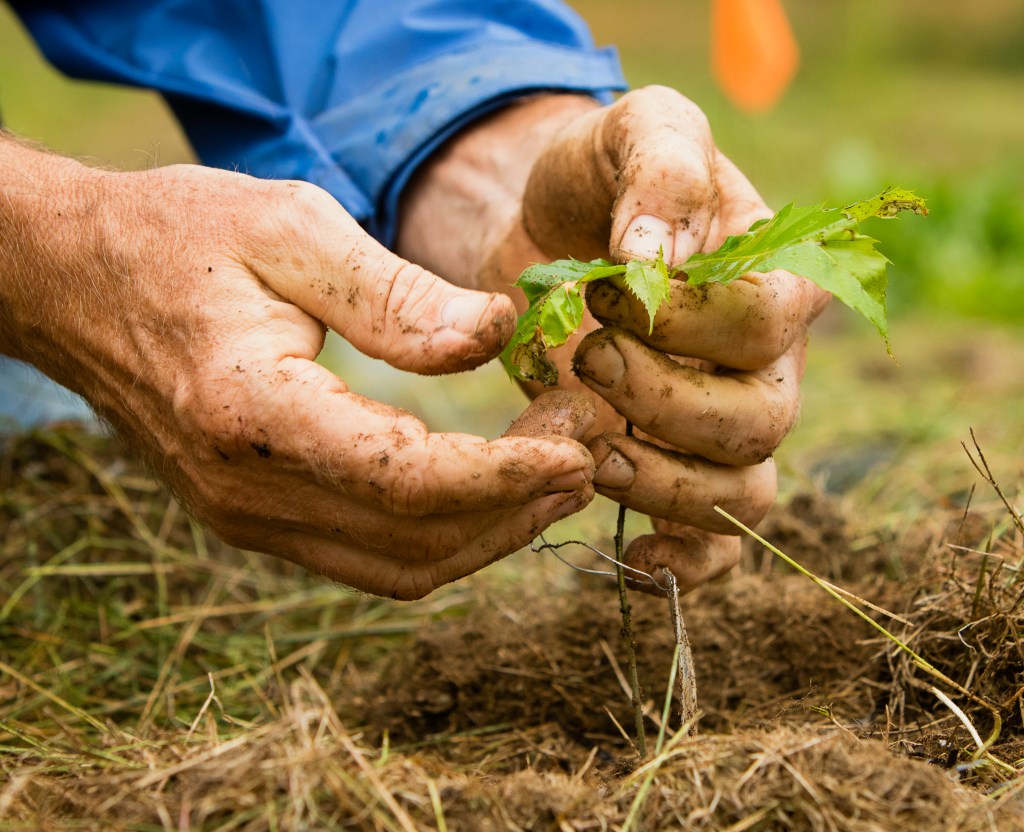SACO — Tom Klak is getting soaked by rain as he checks on his little orchard of 100 American chestnut saplings on an organic farm down the road from his house. The young trees, planted in rows 10 feet apart, have trunks as thin as straws and just a few of the long, canoe-shaped leaves that are the hallmark of an American chestnut.
But Klak doesn’t mind the showers. It’s been an incredibly dry summer, and one of his precious trees has already died, despite the six thorough waterings he’s given the orchard. The ground, he says, is “absolutely like a desert.” The American chestnuts in this orchard, protected by a solar fence from hungry deer, are being grown from the seeds of wild Maine trees that Klak and his students collected last year and sprouted over the winter in greenhouses at the University of New England (UNE). Klak, a professor of environmental studies at UNE, is also the chairman of the gene conservation committee at the Maine chapter of the American Chestnut Foundation (ACF).
The Saco orchard is one of four so-called “germplasm orchards” that Klak, his students and their research partners created around the state this summer to help preserve the genetic diversity of the surviving chestnut trees in Maine’s forests.
It’s the latest project in a much grander, national plan to bring back the American chestnut, a tree that was once as much a part of the American identity as a pilgrim’s footprint or frontier tales of Daniel Boone.
Maine’s chapter of the American Chestnut Foundation is particularly active in these national conservation efforts.
Out of the rain, Klak talks about how the tree that was once known as the “redwood of the north,” used to make everything from flour to floorboards, is now “functionally extinct.”
“I think of it as the miracle tree,” Klak said. “It just has so many positive qualities, and that’s what motivates me to work so hard on bringing it back.”
‘WHERE THERE BE MOUNTAINS, THERE BE CHESTNUTS’
Four billion American chestnut trees once grew in the eastern forest, from Maine to Mississippi, according to Jared Westbrook, director of science at the American Chestnut Foundation based in Asheville, North Carolina. One out of four trees in Appalachia was a chestnut. They were so abundant that the Spanish explorer DeSoto wrote during his 1540 expedition: “Where there be mountains, there be chestnuts.”
The American chestnut was a keystone species, meaning many animals – including turkeys, bears, raccoon, deer and squirrels – relied on them for food. Unlike oaks, which shed their acorns in boom-and-bust cycles, chestnut trees are consistent providers. In autumn, the chestnut burrs on the forest floor could be a foot deep.
People also relied on the tree, gathering nuts to sell; to fatten livestock; and to make flour, ice cream and beer. They roasted the nuts, candied them and stored them for winter. Chestnut wood, which is incredibly rot resistant, was used in barns, homes and fencing, and for railroad ties.
Then along came the chestnut blight, a fungal pathogen accidentally introduced in shipments of young trees from Japan in the early 20th century. The disease swept through the eastern forests, and within 50 years, the pure American chestnut was gone.
Healthy trees, that is. Some trees remain – and even produce nuts – but all are susceptible to the blight, and it’s rare that one would survive for decades like their ancestors once did.
The vast majority of American chestnut sprouts in eastern forests don’t even make it to their first flowering, according to the American Chestnut Foundation.
Scientists are using the trees that do survive in several ways to try to save the species:
• Thirteen of the American Chestnut Foundation’s 16 chapters are participating in a hybridization program in which American chestnut trees are crossed with Chinese chestnuts, which are more resistant to the blight.
The most blight-resistant trees that result from that cross are then back-crossed to create a new generation of blight-resistant trees with more American chestnuts characteristics. And so on. Eventually, these hybrid trees are one-sixteenth Chinese chestnut and 15/sixteenths American chestnuts.
If the hybrid tree were a 180-page book, the Chinese chestnut genes would represent 11 pages, according to Bill Powell, a forest biotechnologist at the State University of New York’s College of Environmental Science and Forestry and co-director of the American Chestnut Research & Restoration Project.
“We’re now at the point where we have the sixth generation in Maine,” Klak said. “We’re in the process in the next couple of years of selecting what we consider the best 10 percent of the trees that are relatively blight resistant. That’s a major step forward at the state level.” (Maine’s chapter of the ACF was founded in 1999, after locals became concerned that the infamous ice storm of 1998 would speed the demise of the state’s remaining chestnut trees.)
Those 10 percent are chosen both for their looks – their American chestnut characteristics – and level of blight resistance. Researchers in Virginia will then use genetics to further whittle down to the top 1 percent of disease-resistant trees.
Maine has 13 breeding orchards scattered around the state in which fourth-generation hybrids are being used to produce the fifth generation of disease-resistant trees, Klak said. And the state has five seed orchards, where a sixth generation of the most disease-resistant trees yet are growing.
“Maine is like the A student in the American Chestnut Foundation,” Westbrook said. “They are really ahead of the game in terms of planting their seed orchards.”
Six of the disease-resistant hybrids were planted in July at Harbor View Park, part of an “edible hillside” planned by the West End Neighborhood Association.
• Scientists at the State University of New York have been working on a transgenic chestnut tree by inserting a wheat gene into the American chestnut genome. The gene detoxifies the fungal blight so it can’t kill the tree. If this tree is declared safe to use by the federal government, it will be up to each state, including Maine, to decide whether or not to propagate and plant it. (See sidebar.)
• Scientists are also working with a virus that attacks the fungus and protects the tree. Maine is not involved in this project, but could benefit from it, Klak said, which is “useful to think about because our ultimate solution is very likely to be a blend of these solutions, a combination, a layering of solutions that will be the best protection for the tree.”
• Not all states that once had American chestnuts in the wild still have them. But those that do, like Maine, are collecting nuts from these wild trees and growing them in orchards as a way to preserve the local biological diversity.
Klak’s project at the University of New England is partnering with Unity College and the University of Maine-Orono.
Like the other Maine orchards already mentioned, his four additional conservation orchards are scattered around the state.
“We’re totally excited to be able to support the preservation of these trees,” said Jim Rough, owner of Wild Meadow Farm, where the Saco orchard is located. “It’s been a fun project to be a part of.”
The other orchards are in Georgetown; Dover Foxcroft, which is on the northern edge of the American chestnut range in Maine; and Long Island, a 4,800-acre island that is almost entirely protected by Acadia National Park. These orchards are planted with seedlings grown from 15 different source trees, or “mother trees,” from Maine, New Hampshire, Vermont and even Tennessee and the Carolinas. Maine still has plenty of wild trees, although most are probably dying from the blight, Klak says. But preserving the genetic diversity of the remaining wild trees is important because Maine is on the edge of the chestnut’s range, Westbrook says. There is less blight here than in the south, and some trees are “escapes,” he said. Take, for example, the nation’s tallest known American chestnut, a 115-foot-tall beauty discovered in Lovell two years ago.
“I think that one’s an escape,” Westbrook said. “It hasn’t gotten the blight yet.”‘
Maine trees might also have some important, adaptive diversity for cold tolerance built into them, which the scientists hope to exploit; it’s far easier to do so when the trees are in orchards than when the scientists must trek through forests to study their specimens.
Though Maine’s chestnut trees have less genetic diversity than those in Appalachia, Klak said, “What we do have is a lot of wild trees producing seeds. A lot of other states don’t have that.”
THE HUNT FOR THE WILD CHESTNUT
Klak tracks down wild trees in a variety of ways. Last October, for instance, he got a call from a Cumberland farmer, who told Klak that he had trees that had produced a lot of burrs. Klak visited and found “beautiful, old wild trees,” including one that was 60 feet tall.
He was too late to gather more than a handful of seeds, so he plans to go back this fall and harvest a lot more.
Klak also knows the kind of habitat the American chestnut likes, which helps narrow the search.
The trees are found on well-drained, sandy soils, a preference that led Klak to a particular spot in Kennebunk that was basically a big, glacial outwash.
One of Klak’s students is using Geographic Information Systems (GIS) to map all the trees they’ve found around the state.
Klak usually starts collecting seeds in early October. It’s a race to get to them before the birds and squirrels.
American chestnuts have both male and female reproductive parts, but they still have to be close enough to other trees to produce seeds.
“There’s a lot of what they call isolates in Maine – big, beautiful chestnut trees that are too far away from any other chestnut tree to reproduce,” Klak said.
Once Klak finds seeds, he puts them in moist peat moss in a plastic bag and places them in the refrigerator to simulate winter. Without that exposure to cold, they won’t grow. They sprout in January.
Klak teaches a course on ecological restoration every spring. This year, he used the American chestnut project as a lesson. He had his students pot the sprouted seeds, grow them out, and plant them in the new orchards.
The saplings are now about 2 feet tall.
It will take about five years for these trees to make their own seeds. Even if they get the blight, they will still be able to reproduce.
In a parallel project, scientists in Asheville, North Carolina, are screening for resistance to a second pathogen that affects the roots of the American chestnut.
The pathogen, which has killed trees in the southeast, is spreading north because of climate change, Westbrook said. It is expected to reach New England in the next 80 years. Maine is sending seeds to that project.
Ultimately, Westbrook said, the idea is to cross that research with the transgenic chestnut trees “and combine resistance to two pathogens in a single tree.”
Klak is hopeful that, no matter how long it takes, the American chestnut can be saved, and some day other species in trouble, such as ash and hemlock, too.
“It would be an amazing ecological turnaround,” he said, “and it could be a model for ecological restoration as a whole. We have a lot of trees that are being subjected to different kinds of pathogens. So if we can turn this around for this keystone species, then it could be a model for bringing back healthy forests.”
Meredith Goad can be contacted at 791-6332 or at:
mgoad@pressherald.com
Twitter: MeredithGoad
Send questions/comments to the editors.











